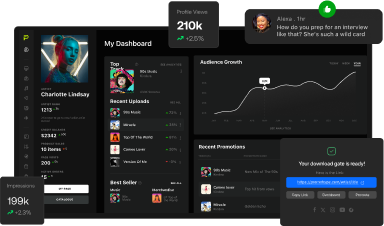
Music has its own vocabulary, and music terms are the instructions that explain how a song should be played, sung, or produced.
From tempo and rhythm to dynamics and expression, these terms give musicians a shared language for creating and interpreting music.
Whether you’re writing, performing, or producing, understanding music terminology makes it easier to communicate ideas, follow notation, and shape your sound with intention.
With that in mind, we’ve compiled a list of 100 essential music terms to help you express your ideas clearly and create the music you love with ease.
Get Early Access
To Promo Hype
What Are Music Terms?
Music terms are expressions relating to how music should be performed and produced to achieve the desired artistic expression.
Foundational to songwriting, music terms indicate the pace and rhythm of a piece, along with loudness, dynamics, and other qualities.
They allow musicians to understand the overall tone and expression expected from them during a recording session or live performance.
In this sense, music terms are essential for collaboration, keeping all parties on the same page when creating a musical piece.
Music terms are also critical when becoming a music producer and using the software’s features to their full potential.
While there are in-depth Latin terms used for classical music, this guide primarily focuses on general terms applicable to contemporary artists.
Why Is Music Terminology Important For Artists?
As with all art forms, the stronger your vocabulary for music terminology is, the more effectively you can work on a musical composition.
Here are some of the key reasons why learning music terms is significantly beneficial for artists working today:
- The ability to fine-tune compositions: An expanded knowledge of music terms is essential for making music with an expansive repertoire of compositional skills. The more terms and concepts you know, the more flexible and creative your musical technique becomes.
- Understanding sheet music: If you’re focusing on traditional songwriting or Western music genres, reading sheet music will enable a considerably more refined approach to writing. It’s also a solid starting point for learning more complex music theory concepts.
- Facilitating effective collaboration: Songwriters who can read sheet music and notations are better equipped for collaborating with other artists. This skill can make it easier to get gigs as a musician or work as a session musician in a studio.
- Laying the foundations for improvisation: Improvisation is a highly creative expression of musical abilities, particularly in jazz and other avant-garde genres. It requires an intuitive grasp of key, harmony, and rhythm to master improvisations and perform with effortless fluidity.
By learning and applying the core music terms when creating a piece of music, artists can forge a distinctive, recognizable sound.
Learn more: How to promote your music.
Music Terms Glossary: 100 Essential Musical Terms to Know
If you’re a novice songwriter or looking for a refresher on the essential music terms, we’ve covered everything you need to know.
Here’s our list of 100 musical terms that can help you write with clarity, communicate your ideas, and collaborate more effectively.
1. A Cappella
A Cappella refers to a performance by one or more singers without any instrumental music, derived from the Italian for “in the chapel style.”
2. ABA Form
The ABA form is commonly used in popular music genres, comprising a distinctive opening and closing section with a contrasting middle section.
3. Accent
An accent represents a stress or emphasis on a specific note, from which musicians can add texture and emotional resonance.
4. Accidental
In music notation, an accidental is a symbol used to indicate an alteration to a given pitch, the most common being flats and sharps.
5. Acoustic
Acoustic refers to instruments that produce sound through organic means, in contrast to electronically produced sounds.
Many singer-songwriters start their music career performing acoustic-driven sets on guitars and other instruments.
6. Afterbeat
In percussion instruments, an afterbeat refers to a strong accent sounded on the off-beats (such as beats 2 and 4 in 4/4 time).
7. Arrangement
The term arrangement refers to the adaptation of an existing composition, commonly taught in music production courses for remixing.
8. Audio Signal
An audio signal refers to the digital representation of a given sound, and applies to recording and mixing and mastering tracks.
9. Atonal Music
Composers looking to expand listening horizons sometimes use atonal music, which eschews conventional rules surrounding tonality.
10. Attack
Attack refers to the initial sound of a note or effect, which can be manipulated using audio compression and other production tools.
11. Bar (Measure)
A bar, also referred to as a measure, is a segment of a musical composition used to indicate one or more recurring beats.
12. Bass/Bass Line
Bass refers to low-frequency-spectrum sounds, with a bass line, a melodic expression typically performed on bass guitars.
13. Beat
The beat of a song’s structure represents its heartbeat, organized into bars and central to the function of a metronome.
14. Block Chords
Block chords represent a specific type of chords that apply a harmonizing technique by layering multiple chords together.
15. Body Percussion
Body percussion is the act of using body parts for rhythmic effect, such as clapping hands, stomping feet, and clicking the tongue.
16. BPM (Beats Per Minute)
Beats per minute (BPM) is a way to measure tempo quantitatively, with a higher BPM value indicating a faster speed.
17. Broken Chord
A broken chord is when two or more notes are played consecutively, as opposed to standard chords, in which notes are played simultaneously.
18. Bridge
A bridge is part of a musical composition connecting two sections of a song, such as connecting the verse to the subsequent chorus.
19. Cadence
Drawn from the Latin word, cadence refers to a musical phrase that serves to punctuate an emotional element and create resolution.
20. Call And Response
The compositional technique known as call and response is when two distinct musical tones work in unison to act as a conversation.
21. Canon
Canon refers to the body of music written by an individual composer or singer-songwriter, as well as a compositional technique for introducing melodies.
22. Cantata
A typical music theory term for classical music, a cantata refers to a vocal composition with a limited instrumental accompaniment.
23. Cardioid
When recording vocals, most producers opt for a cardioid microphone, which minimizes room reflections and delivers superior audio results.
24. Chamber Music
Chamber music refers to when a small group performs together, and is historically associated with intimate settings.
25. Chant
The chant originated in religious music, with a female or male singing voice repeating melodic lines and spiritual phrases.
Recommended read: The best music production software.
26. Chord
A chord is the performance of two or more notes played together to create harmonic consonance or dissonance.
27. Chorus
In musical composition, the chorus is the standout section of a piece of music, featuring catchy lyrics and memorable melodies.
It can also refer to an effect widely used in music production, with many free VST plugins incorporating a chorus tool.
28. Chromatic Scale
Also known as the twelve-tone scale, a chromatic scale consists of an octave’s complete twelve pitches and can be used to create tension.
29. Coda
In a piece of music, the coda is the closing passage or musical notes that draw the music toward its conclusion.
30. Consonance
Consonance refers to note, chord, and interval combinations in a piece of music that create a harmonious and pleasing sound.
31. Counterpoint
Counterpoint relates to the compositional craft of combining independent melodies into a coherent, harmonious form.
32. Crescendo
A crescendo is a gradual increase in musical volume and intensity, indicated on a song structure template with the hairpin symbol (<) or the text “cresc.”
33. Decay
In contrast to attack, decay references the time taken for a sound to run down from the initial peak before reaching a sustained level.
34. Delay
An audio signal processing technique, delay introduces a lag between the original sound and its reproduction for an echo-like effect.
35. Dissonance
Related to consonance, dissonance is when the notes, chords, and intervals used build anticipation and tension in compositions.
36. Drone
A drone in music is a sustained background noise or repeated sound or note that underlies the other elements of a piece of music.
37. Duet
A duet is a musical performance featuring two singers, with many high-profile duets featuring in contemporary music.
38. Dynamics
Dynamics are fundamental to what music producers do, referring to variations in loudness and softness throughout a piece of music.
39. Eighth Note/Notes
An eighth note, referred to as a quaver in British terminology, is a note that lasts one eighth the duration of a whole note.
40. Elegy
A musical elegy is a composition that is designed to express sorrow, with an etymology that relates to the same term in poetry.
41. Encore
An encore is an ad hoc, additional performance from a singer, band, or DJ, typically conducted following rapturous audience applause.
42. Ensemble
A musical ensemble refers to a group of musicians working together to perform or record music collectively.
43. Fade
In music production and audio engineering, a fade is when the audio signal level is gradually increased or decreased.
44. Fifth
A fifth, commonly referred to as a perfect fifth, is a musical interval that provides the framework for multiple chords with a clean, resonant sound.
45. Form
The term form relates to the overall compositional shape, ranging from a lively dance form to slow and stately variations.
46. Forte
Forte is a classical music term that translates to loud, used to signify the dynamics of musical sounds and often included in piano music.
47. Fugue
A contrapuntal compositional technique, the term fugue relates to two or more melodies to create interweaving voices.
48. Grace Note
Another common notation in songwriting, a grace note is a fast ornamental note used to embellish a melody or introduce rhythmic flair.
49. Groove
A musical groove is the underlying rhythmic sensation and flow of a piece of music, with characteristics including syncopation and microtiming.
50. Grid
A grid in music production is a visual framework through which producers can organize the timing of musical elements in a digital audio workstation.
Get Early Access
To Promo Hype
51. Half Note
A half note, called a minim in British music theory, is a note performed for half the duration of a whole note, contrasting with a half step, which refers to a musical interval.
52. Harmonics/Harmony
Harmony refers to the simultaneous performance of different notes, creating chords with consonance or dissonance.
53. Hook
A hook is a short musical phrase or riff that is used in popular music by independent artists and established, mainstream songwriters.
54. Interlude
A musical interlude is a short and contrasting passage in a musical composition that serves as a transitional element.
55. Interval
In music composition, the interval refers to the difference in pitch between two notes, represented horizontally, linearly, or melodically.
56. Intro
An intro is a short section of a piece of music that appears at the beginning, announcing the piece’s key and the song’s tone.
57. Impromptu
An impromptu is an improvised work of music, with music composed by Schubert and Chopin among the best known examples.
58. Intonation
Intonation refers to the accuracy of pitch for an instrument or vocal range, with good intonation indicating the performance is in tune.
59. Key
The term key references the principal note grouping for a piece of music and the subsequent building blocks for harmonies.
60. Key Signature
A key signature is an indication of whether notes should be played higher or lower than their natural pitch, represented in music by treble and bass staves.
Composers can reference the circle of fifths for a visual guide to key signatures, particularly when working with a keyboard instrument.
61. Lead Sheet
A lead sheet represents a simplified form of notation that lacks the full details of a music score, emphasizing the core melody and chords.
62. Ledger Lines
Ledger lines are another musical notation term, used as horizontal lines to extend a musical staff when the pitch exceeds the standard boundaries.
63. Leitmotif
Derived from German, a leitmotif is a recurring musical phrase that is associated with a character or underlying theme of a piece of music.
64. Lyric/Lyricist
Lyrics are the words that make up a song, with lyricists referring to the person or persons responsible for the lyrics.
Lyrists often work closely with singers when collaborating in the recording studio to ensure their vocal range matches the emotional intent.
65. Major Keys
Major keys are musical notes comprised around the major scale, often used when writing bright and uplifting compositions.
66. Measure
Also known as a bar, a measure is a segment of a musical composition based around a pre-determined number of beats and time signature.
67. Melody
A song’s melody is a sequence of notes that form a coherent tune, organized rhythmically and featuring motifs and phrases.
68. Meter
Meter refers to the structure of a track’s beats into repeated patterns that provide the underlying rhythmic framework.
69. Middle C
Middle C is the central note on a piano, also referred to as C4, which acts as a reference point in music theory and when learning sheet music.
70. Minor Keys
Contrasting major keys, minor keys are musical notes comprised around the minor scale that can be used to create a sense of drama and tension.
71. Modulation
Changes in tonality within a composition are known as modulation, with chords and cadences used when transitioning to the new key.
Producers can utilize complex modulation plugins to achieve this effect in their preferred digital audio workstations.
72. Motif
In music, a motif refers to a short musical phrase that recurs throughout a piece to deliver a foundational building block.
73. Natural
Natural in musical notes refers to those that are played in the original, unaltered pitch, without a sharp or flat.
74. Notation
Musical notation is the visual representation of notes using a variety of marks and symbols to indicate tempo, rhythm, and pitch.
In music production software, the MIDI format is often used to represent aspects of notation and sound modulation visually.
75. Octave
An octave, sometimes called a perfect octave, is the interval between two notes, with the second note the same note but at a higher pitch.
Essential reading: The 10 best digital audio workstations.
76. Orchestra/Orchestral Composition
Orchestral music is performed on a range of instruments, including sections for brass, wind, string, and percussion instruments.
Artists often attend music production schools to learn the complexities of orchestral compositions and gain musical direction.
77. Ornament
Ornament in music refers to compositional flourishes and additional notes that augment the core melodies of the arrangement.
78. Overdubbing
The term overdubbing relates to a standard music production technique in which additional musical layers are added to audio.
It’s used for complex vocals and rich arrangements, as well as punching in fresh takes to fix recording issues.
79. Pentatonic Scale
A pentatonic scale is a scale that incorporates five notes per octave, contrasting the seven notes used in heptatonic scales.
80. Polyphony
Polyphony occurs in music when two or more independent melodies are combined, each with its own distinct identity.
81. Polyrhythm
Polyrhythm functions similarly to polyphony, with two or more rhythmic patterns playing together to combine the unique qualities of each.
82. Polyphonic
Polyphonic is the adjective to the noun polyphony, referencing interwoven sounds and melodies, and is used in fugues and canons.
83. Range
Range can refer to a singer’s vocal range, or the lowest and highest notes they can sing, or the dynamic range between quiet and loud elements.
The latter is a core consideration when mixing music and ensuring all the notes and sounds are well-balanced.
84. Refrain
The term refrain, also used in poetry, is a recurring line of lyrics used in a song, often used synonymously for the chorus.
85. Register
The register of an instrument or vocalist refers to the full range of pitch available and how these can impact a musical idea.
86. Release
The term release is related to attack, decay, and sustain, referencing the final stage when a given key fades back to silence.
87. Rhythmic Notation
An aspect of standard music notation, rhythmic notation indicates the duration of sounds and silences, represented via notes and rests.
Software such as Steinberg Dorico Studio features in-depth notation tools for writing music in line with music theory best practices.
88. Riff
A musical riff is similar to a motif, representing a short, memorable element of a musical composition, often featured in rock and punk.
89. Scale
A musical scale is a sequence of consecutive notes that progress through an octave, usually by order of pitch.
90. Sequence
A sequence represents the repetition of a musical pattern, such as musical notes or chords, transposed to a new pitch.
91. Solo
A solo is a section of a composition in which one vocalist or musician performs the arrangement, either in isolation or with an ensemble backing.
92. Tempo/Tempo Marking
Tempo refers to the speed of a musical piece, while tempo markings are instructions that composers use when indicating speed to performers.
93. Time Signature
A foundation of music theory for producers and songwriters, the time signature refers to the rhythmic structure of a song.
Represented like a fraction, the top number refers to the beats in each bar, while the bottom number denotes the note value that receives a beat.
94. Tone
Tone can refer to the character of a sound, a specific note, or a whole-step interval, depending on context.
95. Transcription
Transcription in music is when music is converted from its audio roots into a written format, such as in musical notation and sheet music.
Explore more: The best music production equipment.
96. Tune/Tuning
In music, a tune is defined by a succession of melodic notes that form a song, while tuning refers to adjusting an instrument to achieve the correct pitch.
97. Upbeat
Upbeat music typically has a faster tempo and an uplifting mood, and can also refer to the rhythmic function of an unstressed/unaccented beat.
98. Variation
A variation in music is when the song’s original elements are reconfigured by changes to tempo, pitch, and other values.
99. Verse
In songwriting, the verse is the section that drives narrative, used by the best music producers to establish the track’s core elements.
100. Whole Note/Rest/Step
A whole note is the longest note in music composition, with whole rests and steps indicating pauses and transitions between notes.
Summary
Every artist has a unique creative voice, but music terminology gives us a shared language to bring those ideas to life.
The more fluent you become with these musical terms, the easier it is to shape your sound and collaborate with confidence.
No matter your style, mastering the fundamentals above will help you transform inspiration into unforgettable music.
Get Early Access
To Promo Hype
Join Promo Hype






